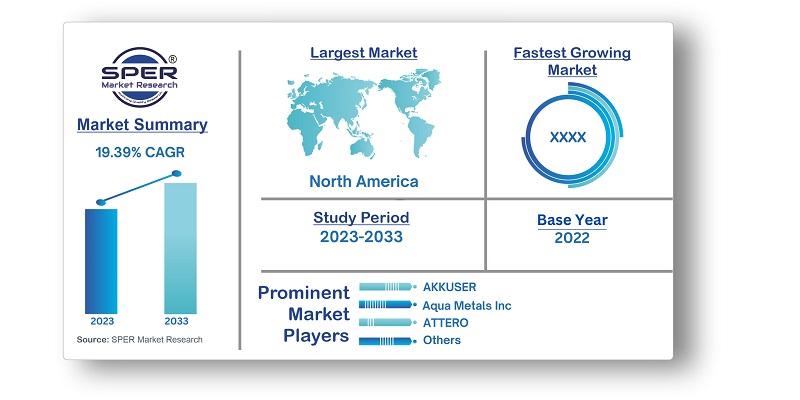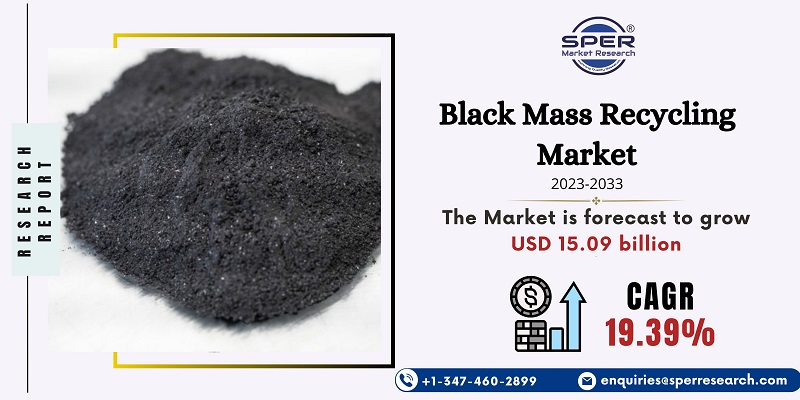
Black Mass Recycling Market Growth, Size, Trends, Revenue, Demand, Share and Future Outlook
Black Mass Recycling Market Size- By Battery Source, By Technology, By Recovered Metal, By Application, By Battery Type- Regional Outlook, Competitive Strategies and Segment Forecast to 2033
| Published: Jan-2024 | Report ID: CHEM2407 | Pages: 1 - 227 | Formats*: |
| Category : Chemical & Materials | |||
- February 2023; Umicore is bringing manganese-rich battery material technologies for electric vehicles to the mass market. The noteworthy accomplishment broadens Umicore's portfolio of NMC battery materials for high productivity and long-range electric vehicles.
- September 2022; General Motors Co. and Lithion Recycling strategically invested in Lithion Recycling's Series A fundraising round to use Lithion Recycling's state-of-the-art battery recycling technology to create a circular battery ecosystem.


| Report Metric | Details |
| Market size available for years | 2019-2033 |
| Base year considered | 2022 |
| Forecast period | 2023-2033 |
| Segments covered | By Battery Source, By Technology, By Recovered Metal, By Application, By Battery Type |
| Regions covered | North America, Asia-Pacific, Latin America, Middle East & Africa and Europe |
| Companies Covered | AKKUSER, Aqua Metals Inc., ATTERO, BASF SE, Duesenfeld, ECOGRAF, ELECTRA, Exigo Recycling Pvt. Ltd., Fortum, Green Li-ion Pte Ltd. and others. |
- Electronic Device Manufacturers
- Battery Producers
- Environmental Organisations
- Electric Vehicle Manufacturers
- Renewable Energy Companies
- Investors
| By Battery Source: |
|
| By Technology: |
|
| By Recovered Metal: |
|
| By Application: |
|
| By Battery Type: |
|
- Global Black Mass Recycling Market Size (FY’2023-FY’2033)
- Overview of Global Black Mass Recycling Market
- Segmentation of Global Black Mass Recycling Market By Battery Source (Automotive Batteries, Industrial Batteries, Portable Batteries)
- Segmentation of Global Black Mass Recycling Market By Technology (Hydrometallurgy, Pyrometallurgy)
- Segmentation of Global Black Mass Recycling Market By Recovered Metal (Cobalt, Copper, Lithium, Manganese, Nickel)
- Segmentation of Global Black Mass Recycling Market By Application (Aerospace and Defence, Automotive, Construction, Consumer Electronics, Energy)
- Segmentation of Global Black Mass Recycling Market By Battery Type (Nickel-Cobalt Manganese Battery, Nickel-metal Hydride Battery)
- Statistical Snap of Global Black Mass Recycling Market
- Expansion Analysis of Global Black Mass Recycling Market
- Problems and Obstacles in Global Black Mass Recycling Market
- Competitive Landscape in the Global Black Mass Recycling Market
- Impact of COVID-19 and Demonetization on Global Black Mass Recycling Market
- Details on Current Investment in Global Black Mass Recycling Market
- Competitive Analysis of Global Black Mass Recycling Market
- Prominent Players in the Global Black Mass Recycling Market
- SWOT Analysis of Global Black Mass Recycling Market
- Global Black Mass Recycling Market Future Outlook and Projections (FY’2023-FY’2033)
- Recommendations from Analyst
1.1. Scope of the report1.2. Market segment analysis
2.1. Research data source2.1.1. Secondary Data2.1.2. Primary Data2.1.3. SPER’s internal database2.1.4. Premium insight from KOL’s2.2. Market size estimation2.2.1. Top-down and Bottom-up approach2.3. Data triangulation
4.1. Driver, Restraint, Opportunity and Challenges analysis4.1.1. Drivers4.1.2. Restraints4.1.3. Opportunities4.1.4. Challenges4.2. COVID-19 Impacts of the Global Black Mass Recycling Market
5.1. SWOT Analysis5.1.1. Strengths5.1.2. Weaknesses5.1.3. Opportunities5.1.4. Threats5.2. PESTEL Analysis5.2.1. Political Landscape5.2.2. Economic Landscape5.2.3. Social Landscape5.2.4. Technological Landscape5.2.5. Environmental Landscape5.2.6. Legal Landscape5.3. PORTER’s Five Forces5.3.1. Bargaining power of suppliers5.3.2. Bargaining power of buyers5.3.3. Threat of Substitute5.3.4. Threat of new entrant5.3.5. Competitive rivalry5.4. Heat Map Analysis
6.1. Global Black Mass Recycling Market Manufacturing Base Distribution, Sales Area, Product Type6.2. Mergers & Acquisitions, Partnerships, Product Launch, and Collaboration in Global Black Mass Recycling Market
7.1. Global Black Mass Recycling Market Value Share and Forecast, By Battery Source, 2023-20337.2. Automotive Batteries7.3. Industrial Batteries
7.4. Portable Batteries
8.1. Global Black Mass Recycling Market Value Share and Forecast, By Technology, 2023-20338.2. Hydrometallurgy8.3. Pyrometallurgy
9.1. Global Black Mass Recycling Market Value Share and Forecast, By Recovered Metal, 2023-20339.2. Cobalt9.3. Copper9.4. Lithium9.5. Manganese9.6. Nickel
10.1. Global Black Mass Recycling Market Value Share and Forecast, By Application, 2023-203310.2. Aerospace and Defence10.3. Automotive10.4. Construction10.5. Consumer Electronics10.6. Energy
11.1. Global Black Mass Recycling Market Value Share and Forecast, By Battery Type, 2023-203311.2. Li-on Battery11.3. Nickel-Cobalt Manganese Battery11.4. Nickel-metal Hydride Battery
12.1. Global Black Mass Recycling Market Size and Market Share
13.1. Global Black Mass Recycling Market Size and Market Share By Battery source (2019-2026)13.2. Global Black Mass Recycling Market Size and Market Share By Battery Source (2027-2033)
14.1. Global Black Mass Recycling Market Size and Market Share By Technology (2019-2026)14.2. Global Black Mass Recycling Market Size and Market Share By Technology (2027-2033)
15.1. Global Black Mass Recycling Market Size and Market Share By Recovered Metal (2019-2026)15.2. Global Black Mass Recycling Market Size and Market Share By Recovered Metal (2027-2033)
16.1. Global Black Mass Recycling Market Size and Market Share By Application (2019-2026)16.2. Global Black Mass Recycling Market Size and Market Share By Application (2027-2033)
17.1. Global Black Mass Recycling Market Size and Market Share By Battery Type (2019-2026)17.2. Global Black Mass Recycling Market Size and Market Share By Battery Type (2027-2033)
18.1. Global Black Mass Recycling Market Size and Market Share By Region (2019-2026)18.2. Global Black Mass Recycling Market Size and Market Share By Region (2027-2033)
18.3. Asia-Pacific18.3.1. Australia18.3.2. China18.3.3. India18.3.4. Japan18.3.5. South Korea18.3.6. Rest of Asia-Pacific18.4. Europe18.4.1. France18.4.2. Germany18.4.3. Italy18.4.4. Spain18.4.5. United Kingdom18.4.6. Rest of Europe18.5. Middle East and Africa18.5.1. Kingdom of Saudi Arabia18.5.2. United Arab Emirates18.5.3. Rest of Middle East & Africa18.6. North America18.6.1. Canada18.6.2. Mexico18.6.3. United States18.7. Latin America18.7.1. Argentina18.7.2. Brazil18.7.3. Rest of Latin America
19.1. AKKUSER19.1.1. Company details19.1.2. Financial outlook19.1.3. Product summary19.1.4. Recent developments19.2. Aqua Metals Inc.19.2.1. Company details19.2.2. Financial outlook19.2.3. Product summary19.2.4. Recent developments19.3. ATTERO19.3.1. Company details19.3.2. Financial outlook19.3.3. Product summary19.3.4. Recent developments19.4. BASF SE19.4.1. Company details19.4.2. Financial outlook19.4.3. Product summary19.4.4. Recent developments19.5. Duesenfeld19.5.1. Company details19.5.2. Financial outlook19.5.3. Product summary19.5.4. Recent developments19.6. ECOGRAF19.6.1. Company details19.6.2. Financial outlook19.6.3. Product summary19.6.4. Recent developments19.7. ELECTRA19.7.1. Company details19.7.2. Financial outlook19.7.3. Product summary19.7.4. Recent developments19.8. Exigo Recycling Pvt. Ltd.19.8.1. Company details19.8.2. Financial outlook19.8.3. Product summary19.8.4. Recent developments19.9. Fortum19.9.1. Company details19.9.2. Financial outlook19.9.3. Product summary19.9.4. Recent developments19.10. Green Li-ion Pte Ltd.19.10.1. Company details19.10.2. Financial outlook19.10.3. Product summary19.10.4. Recent developments19.11. Others
SPER Market Research’s methodology uses great emphasis on primary research to ensure that the market intelligence insights are up to date, reliable and accurate. Primary interviews are done with players involved in each phase of a supply chain to analyze the market forecasting. The secondary research method is used to help you fully understand how the future markets and the spending patterns look likes.
The report is based on in-depth qualitative and quantitative analysis of the Product Market. The quantitative analysis involves the application of various projection and sampling techniques. The qualitative analysis involves primary interviews, surveys, and vendor briefings. The data gathered as a result of these processes are validated through experts opinion. Our research methodology entails an ideal mixture of primary and secondary initiatives.



Frequently Asked Questions About This Report
PLACE AN ORDER
Year End Discount
Sample Report
Pre-Purchase Inquiry
NEED CUSTOMIZATION?
Request CustomizationCALL OR EMAIL US
100% Secure Payment






Related Reports
Our Global Clients
Our data-driven insights have influenced the strategy of 200+ reputed companies across the globe.




















